
 Mine Train Thru Nature’s Wonderland was one of Walt Disney’s greatest achievements and it is often said that it was his favorite attraction at Disneyland. It existed in some form from July 1956 through January 1977. There was a connection to Disney films with this attraction. Parts of it, such as Beaver Valley, Bear Country and the Living Desert, were named after, and tied in with, entries in Disney’s series of documentary films called "True Life Adventures," which were produced from 1948 through 1960. The attraction that replaced the Mine Train (at least part of its real estate), the Big Thunder Mountain Railroad, opened in 1979 and offers the visceral thrill of speed but lacks the imagination, charm, setting, scenery, and character of the original Mine Train attraction. Like millions of other visitors to Disneyland in the 1960s and 1970s, I'm lucky to have gotten to ride the Mine Train maybe a dozen times. Hopefully this description, along with the many vintage photos here on this site, can help the reader re-create the experience in their mind.
Mine Train Thru Nature’s Wonderland was one of Walt Disney’s greatest achievements and it is often said that it was his favorite attraction at Disneyland. It existed in some form from July 1956 through January 1977. There was a connection to Disney films with this attraction. Parts of it, such as Beaver Valley, Bear Country and the Living Desert, were named after, and tied in with, entries in Disney’s series of documentary films called "True Life Adventures," which were produced from 1948 through 1960. The attraction that replaced the Mine Train (at least part of its real estate), the Big Thunder Mountain Railroad, opened in 1979 and offers the visceral thrill of speed but lacks the imagination, charm, setting, scenery, and character of the original Mine Train attraction. Like millions of other visitors to Disneyland in the 1960s and 1970s, I'm lucky to have gotten to ride the Mine Train maybe a dozen times. Hopefully this description, along with the many vintage photos here on this site, can help the reader re-create the experience in their mind.
This attraction began its life as the Rainbow Caverns Mine Train in 1956, but was later expanded and renamed The Mine Train Thru Nature's Wonderland in 1960. The ticket history of the ride is interesting: it began as a "D" ticket (50¢) when it opened in 1956, and at that time D tickets were the "top of the line" attractions. However, when E tickets were introduced to the ticket books in 1959, the Rainbow Caverns Mine Train was lowered to "C" ticket status (30¢), and the attraction was closed for rehabilitation and expansion. Then in 1960 it was reopened as the Mine Train Thru Nature's Wonderland, and it was initially given its "D" ticket status back (35¢). That was not the "top of the line" any more, as "E" tickets were in use by that time. It was finally given "E" ticket status in 1961 (50¢ and later 60¢), not too
long after it reopened under its new name. Mine Train expert James Keeline speculates that the change may have been a reaction to the ride's greater popularity after the makeover. In 1963 or 1964, it was moved back to the "D" tickets (45¢ and later 60¢) and remained there until 1971, when it was bumped up to "E" again (75¢). Finally from 1975 until the attraction's permanent closing in January 1977, it required a "D" ticket (70¢). So people who bought individual tickets for this attraction paid anywhere from 30¢ to 75¢ to get on it, over the course of its entire "lifetime." And the ticket sequence was D-C-D-E-D-E-D over the attraction's life. I'm certain that the cast member that collected my ticket accepted a "C" for it the last time I rode it in the summer of 1976, but that was an anomaly. As far as I am concerned it was "E-ticket quality at any time. Some Disneyland souvenir guides printed around 1961 call it the "Western Mine Train" but I've never seen that on a ticket. Some websites refer to the attraction as "Mine Train Through Nature's Wonderland," but every Disneyland ticket I've seen, and the park's poster, spells it as "Thru" instead of "Through," so I always use "Thru."
Thanks to James at keeline.com, here is a chart of tickets for this attraction:
Rainbow Caverns Mine Train
1956-1959 : D (50¢) [D ticket introduced in mid 1956]
1959 : C (30¢) [E ticket introduced in mid 1959,
attraction closed for rehab]
Mine Train Thru Natures Wonderland
1960 : D (35¢)
1961-1963?: E (50¢, 60¢) [Uncertain if E in 1963]
1964-1970 : D (45¢, 60¢)
1971-1974?: E (75¢) [Uncertain if E in 1974]
1975-1976 : D (70¢) [Tickets stopped printing prices by 1976;
attraction closed early January 1977]
 Also according to James, "Thru" is the official word used in the attraction name. “The Western River Ride” was a proposed attraction that Marc Davis did a fair amount of concept art for; sort of a Jungle Cruise of the west. When this concept was dropped, it is possible that "Western Mine Train" was considered as a title before "Nature's Wonderland" was finally selected for the expansion.
Also according to James, "Thru" is the official word used in the attraction name. “The Western River Ride” was a proposed attraction that Marc Davis did a fair amount of concept art for; sort of a Jungle Cruise of the west. When this concept was dropped, it is possible that "Western Mine Train" was considered as a title before "Nature's Wonderland" was finally selected for the expansion.
The attraction was located in the northern section of Frontierland and was one
of the two "must-see" attractions in Frontierland for our family (the
other being Tom Sawyer Island). Walking towards the loading area, you saw the town of Rainbow Ridge, an old-West style frontier
town. Above the town on a hill with trees was the actual Rainbow Ridge, which
looked very inviting. You could not see any of the attraction itself other
than the section of the track where you got on and the trains that came out of one tunnel, stopped to unload and reload, then disappeared into
another tunnel. There was really no preview of the wonders to come. Thus, there was no excitement of anticipation either, like you would get from the Matterhorn or the Autopia, after seeing a glimpse of
what the attraction was going to be like.
The wait was never very long, though when I was 6 years old
even 15 minutes seemed like a long time! The line moved in bunches rather than a steady flow.
As each train entered the loading area, the passengers who just finished
their journey would get off the train, and a whole group of new passengers
would be let in to get on the train. So the line would move a lot, then
it would sit still until the next train arrived, then move again. When
we got near the front of the line we wondered with excitement, "Will we
get on the next train or not?" And we wanted to pick which car to get into, although when the boarding actually happened you forgot about that
and just went to the nearest car. In later years as the attraction's
popularity apparently dwindled, there was very little or no line at all; in fact, I
remember walking over there and getting right on it one evening. However,
even if you had to wait a few minutes, there was plenty to see while you
were waiting. The façade of false-front "stores" and businesses,
including the "Rainbow Ridge Clarion" and many others, was interesting to study while you were standing there, and with the trees on the ridge above it, the whole frontier town setting was vividly created before you even started the attraction. Hidden in the trees at the top of the hill was
what looked like the machinery of a mine, but the attraction never ventured close to that area. The mine machinery was removed when the track was reconfigured for Nature’s Wonderland. Some buildings were also moved and others added to expand Rainbow Ridge. From 1955 to 1973 there
was a Pack Mules attraction, and part of the path the mules took passed
right in front of these storefronts, but sadly for me I never got to go
on those. There were also two other attraction that used this same general area,
The Conestoga Wagons of 1955-1959 and The Rainbow Mountain Stage Coaches
of 1956-1959. Both were drawn by live horses. Some of the Rainbow Ridge storefronts looked like complete buildings that you could possibly enter, but park visitors were not allowed to actually go in any of them. It gave you something interesting to look at
as you stood waiting for the next train to arrive from a tunnel opening
at the right. One of these businesses represented was a dentist's
office. Another was a hotel, and often emanating from it would be a pre-recorded sound of a
man snoring (presumably a man, though it could have been a lady with a
big nose!). Most
park guests giggled a little at the snoring sound. There were also sounds for the saloon with piano and occasional gun shots. The church bell rang on occasion and the clanking from the blacksmith could also be heard. All of this kept you entertained as you waited to get on the attraction, so that kept it from ever getting boring. It was not likely that you would hear all of the sound effects on a single visit to the attraction, but very likely that you would hear at least one. The one that I remember most clearly was the snoring, and again I am indebted to James Keeline for reminding me of the others. I have seen old films of fake gunfights that were
sometimes performed in front of the storefront façades for the entertainment of the guests waiting, but sadly I never saw one of those
in person either. You couldn't see any of the actual attraction area while you were
waiting. This gave the ride a true sense of adventure because you really
had no idea what you were about to see. The wait was usually just a few minutes, while the attraction itself had a generous duration (approximately nine minutes); quite the opposite of
Disneyland today, with hour-long waits for 3-minute attractions. The green trains had six cars with the narrator on a seat outside the last car. The yellow NW trains had seven cars and the operator was either a live narrator or a taped spiel. The cars had bench seats along each side. The 1971 SOP indicates that the capacity was 74 guests. With seven cars that suggests 10 per car on average plus a few in the cab of the "locomotive". The trains were
yellow when I rode them, with each car having the name of one area of
the attraction on it. I have seen pictures of the trains in earlier years when
they were a dark green color, but they were yellow in the 1960s and
1970s. The small door was opened to let you enter the car; there were sights to see in all directions so it didn’t really matter where you sat; the experience was essentially the same for everyone. When the operator closed the
door, a small bench on the inside of the door (the "jump seat") folded
down to give room for one more person to sit. If you had the luxury of a
sparsely populated car, you could change your position frequently during the ride to get better views of things on one side of the car or the
other. No seat belts or other restraints that are so commonly seen
today. The trains never went fast enough or made sudden enough turns to
warrant seat belts, and there were none of those safety bars that press
down into your lap. You were instructed by the narrator to remain seated
and keep your hands and arms inside the vehicle, as with most attractions, but
that was about it. A no-smoking reminder, too. I remember moving around a
lot and that never caused the operators to stop the train or call me out. People often put their arms on the tops of the car sides,
and that was not enough to cause a stir either. I never saw anyone stand
up or attempt to jump out of a car, even though it would have been easy to do so.
The 1950s, 1960s and 1970s were
different times in the United States than they are today. Since then a
nationwide series of tort lawsuits and increased insurance rates has essentially forced theme parks to install more safety restraints and issue more safety warnings to the passengers. You’ll note that on this page there is a publicity photo showing Walt Disney standing up in the train
during a preview for the media. Other guests on the train at that
moment also have their hands and arms clearly outside the vehicle. Additional note from James: When you are Walt you can do pretty much what you want. However, the photos you mention were photo opportunity VIP tours, often with special guests that Walt was taking around. I'm sure he had the train stopped when he stood up to point out one site of interest or another. The cameras and film were slower then so a non-moving train facilitated a good shot. Many old-time castmembers say that the Mine Train was his favorite attraction in the park and after visiting the Golden Horseshoe he would either turn left to head towards the Jungle Cruise or right to the Mine Train. The CMs would watch which direction he was headed and call ahead so his favorite operator would be waiting when he arrived.
Disney fan Alan Adams recalls hijinks with classmates during Spring Break trips to Disneyland: "Mine Train antics involved jumping off the cars and hiding among in the scenes and then jumping out at the other cars to scare friends who were waiting in line behind us. Like the goblins in Haunted Mansion, on Mine Train you could be one of the goblins yourself. It was fun! Even better if the friend in your car could get a Kodak moment, jumping out at the other cars down the line. It was the ultimate attraction experience to become a part of the set! How long, perhaps 20 seconds, maybe less I can't remember exactly, but a thrilling experience seconds seem like an eternity. Classmates travelled in groups on the attractions. It was no more usually than waiting in line and letting people go ahead in order to get the front car, and a friend at the end of the queue doing the same for the last car in order to plan the seating for that train; then jumping off the front car and getting back into the last car. And if you took too long you'd miss your train! One time I couldn't get back in the last car because friends pushed me off as a joke while trying to get back on. So I had to run back into the set and hide waiting for the next train. And those people on the next train were not from my group of friends, so I was terribly scared myself jumping into another train with kids not from my school who didn't know what was going on and were screaming startled that some goblin was jumping out at them into their car - WITH NO EXTRA SEAT. No, I never got caught on that attraction."
The attraction’s recorded narration was one of the key elements that gave The Mine Train its character. Walt Disney and his crew wisely chose not to
inundate the attraction with music as has been done on so many others.
The narration and the peacefulness of nature was enough. The recording of was made by character actor Dallas McKennon (July 19,
1919 - July 14, 2009) who also voiced some characters in some of the Disney animated films. His voice immediately created in your mind an
image of a "character out of the Old West" but with a decidedly friendly
and folksy tone. In fact the first words on the recording are "Howdy
folks!" It was rather like your hillbilly uncle who lived out in the
woods taking you through a tour of his world, making lame wisecracks
most of the way through. (In 2005, as part of the park's 50th
anniversary celebration, Disney released a set of 6 CDs called "A Musical History of Disneyland” and the recorded narration of this attraction is included on that.) I have read that the train operator could choose
to do a live narration instead of using the recorded one, but that never
happened any time that I rode it. It was always the same familiar, "Howdy
folks!" each time. An interesting side bit of trivia is that when the
Big Thunder Mountain Railroad was being constructed, Dallas
McKennon also recorded the voiceover for that attraction, which is heard by passengers as the journey begins. That "spiel" is much shorter though, heard
only at the beginning, and basically warning riders what not to do, while the narration he recorded for the Mine Train lasted the entire trip.
 The Mine Train ride began with the train entering a tunnel between the buildings of Rainbow Ridge. There was the obligatory warning by the narrator to remain seated and keep your hands and arms inside at all times ("the animals get mighty hungry") and for some reason on this attraction there was also a no-smoking warning. At the time the narration was recorded, smoking was a lot more popular among Americans than it is now. I guess there was a possibility of a discarded cigarette starting a fire among the very real vegetation througout the journey. The narrator said we would be seeing a lot of wildlife, so we should "keep a real sharp hunter's eye." That statement confused me as a kid: was that some sort of tool we were supposed to have and why wasn't I given one?
The Mine Train ride began with the train entering a tunnel between the buildings of Rainbow Ridge. There was the obligatory warning by the narrator to remain seated and keep your hands and arms inside at all times ("the animals get mighty hungry") and for some reason on this attraction there was also a no-smoking warning. At the time the narration was recorded, smoking was a lot more popular among Americans than it is now. I guess there was a possibility of a discarded cigarette starting a fire among the very real vegetation througout the journey. The narrator said we would be seeing a lot of wildlife, so we should "keep a real sharp hunter's eye." That statement confused me as a kid: was that some sort of tool we were supposed to have and why wasn't I given one?
On exiting the tunnel the train entered Beaver Valley, which had a
little pond and there were beavers building a dam. I should mention that
none of the animals seen on the attraction were real; they were all "audio-animatronic" or mostly just "animatronic" because they made no
sounds. There were never any real animals unless they were wild and
happened to take up residence there, such as the birds in the trees or
whatever. In my opinion, the animals were actually pretty well-done and realistic looking - but nobody was ever fooled into thinking that they were live animals. The awkward, mechanical motions they made were the giveaways. Even little kids realized they were fake, but we all played
along with it anyway. For me, the fake animals were never the real stars
of the show, anyway. The real stars for me were the environments and
water features. When we passed some marmots above the next tunnel,
peeking up from rocks at the train, the narrator said they "must be
a-whistlin' to all you pretty gals." This usually elicited an
embarrassed giggle from any young women that happened to be on the train
at that time.
Next the train meandered over to the Cascade Peak area, which was a beautiful
mountain with huge waterfalls flowing down it. It was a very impressive achievement in
and of itself. Kind of like the Matterhorn's "little brother" but with
more waterfalls. The train went behind one large, wide waterfall and
then in front of another waterfall that had multiple drops including the "twin sisters" as the nearest to the train. The walls of water were very
close to the train, and sound of the water was thunderous. Massive
amounts of water were constantly flowing, all day long. They must have
turned it off at night to save on the electricity used by the pumps. Some
adults could reach and just barely touch the water if they tried hard, but kids' arms weren't long enough. I guess the reaching for the water
wasn't enough of a violation of the "keep your hands and arms inside" rule to make the train come to a stop. The narrator called one of the
falls "Twin Sisters, cause they're always babblin." That usually evoked
a polite chuckle from the grandparents, while the kids were still
mesmerized by the powerful sheets of water seemingly inches away from
our reach. As the train went around Cascade Peak, there was a fine view
of one side of Tom Sawyer Island, across the Rivers of America. You
might also see one of the many watercraft that went around the Rivers,
such as the canoes, the keel boats, the Mark Twain or the Columbia; wave
to the people on any of these and see if they wave back, or wave to the people on Tom Sawyer Island and see if any wave back. Behold Walt
Disney's dream, fully realized, landscaped and populated with guests
Awesome.
Then the train entered another tunnel and came out into the Bear River
part of the attraction (this is sometimes referred to as "Bear Country" in
some articles. Deepening the confusion, there was also a land in
Disneyland called Bear Country, which is now called Critter Country).
Immediately after coming out of the tunnel the train crossed a trestle
built over a small lake. The trestle was designed to look rickety, with
beams at odd angles, and to a kid it seemed really high above the water.
It was probably only about 20 feet but it seemed like the water was a
long way down. When you were on the trestle, if you were a kid, you
couldn't see the track below you, just the green water. If you looked
over the edge of the car you could see the track, but it was too scary
to look over. In addition there were 2 small platforms on one side of
the bridge, with large red barrels marked TNT or something. The narrator
didn't mention those, but told us to sit real still, because "No tellin'
how long she's gonna last." That was absolutely the last thing I wanted
to hear at that moment, and it was always a profound relief when the
train left the trestle and went onto solid ground again. In the river below the trestle were 3 sets of bears: one with a fish in its mouth, a
group of 3 bears off to the side, and one scratching its back against a
tree. There was also another bear over by itself standing up. Sometimes you
would see fish jump out of the water (fake fish) but none of those
mattered to me. All I wanted was for the train to get off that damned bridge. The bear pond was a pretty neat area, though, with the jumping
fish and all that. By that point you were deep into the attraction; so deep in fact that you had forgotten all about the long drive to get
there, the parking lot, the ticket books, the long walks, the waiting
lines... all of that stuff was forgotten and you were totally immersed
in the Disneyland experience.
The narrator made a joke about two elk who
were in a conflict over a female elk, "Does gittin' two women-folk mean
yer the winner or the loser?" to which women on the ride would usually
go "Ohhh..." or "Boo!" and at that point it became clear the narrator
was quite the misogynist. I don't think the script for this ride would
be the same if it were being written today.
Visitors to Disneyland today can still see a damaged portion of Bear
River, along the walkway that connects Frontierland to Fantasyland. The
opening of the tunnel is seen along with a remnant of the kid-terrifying
trestle. The water is now a murky bright green, though, nothing like it
was during the ride's heyday. It's either pond scum or they dumped some
green coloring in it. Pretty ugly compared to the natural-looking state it was in during the attraction's lifetime. However the jumping fish are still
seen sporadically. The train then went through Natural Arch Bridge, kind of like something
you would see at Canyonlands or Arches National Parks. When the Pack
Mules attraction was still in operation (1956-1973), you would sometimes
see people riding the live mules across the top of the Natural Arch
Bridge. Entry through this bridge this signaled a complete change in
environment from the lush, leafy, watery world to the
barren, dry desert world. This area was called the Living
Desert, named after the 1953 Disney-produced documentary film. This large area had sparse vegetation, but plenty of rock
formations, modeled after the red sandstone rock of the American
southwest deserts. Some parts of it were reminiscent of Bryce Canyon
National Park.
The train went through a (fake) saguaro cactus forest, designed to look like Saguaro National Monument (now National Park) near
Tucson, Arizona. Many of the fake saguaros were deliberately designed to
suggest the shapes of people, with arms pointing up or down and facial
features consisting of holes in the "cactus" in the right locations.
There were shorter ones too, more like barrel cacti, with short "arms" and the same "eyes" punched as holes, and these had white tufts of hair
on top. There may well have been some real, live saguaro cacti planted amidst the fake ones, and a few other types of cacti planted just as
landscaping, though I'm not really sure. Looking at pictures now I see
some Joshua trees and those might have been live. This part of the ride
was pretty unconvincing, cartoonish and corny, compared to some of the
things that came before and were to come later. An attempt at comedy was
made by showing some small wild pigs or warthogs cornering a bobcat
which was at the top of one of the saguaro, looking down at them with
its head turning slightly. The cat didn't seem to be bothered by the
cactus needles which were probably sticking into its paws. There were a
couple of large rocks and on top of them, fake rattlesnakes whose heads would bobble back and forth as if they were about to strike. You
expected them to suddenly lash out at a passenger any second, but all
they did was move their heads back and forth. There was a roadrunner and
snake poised facing each other in a kind of standoff. A coyote stood
atop another rock and there was a mountain lion crouched and ready to
pounce, atop another rock. These were actually fairly well done and
realistic looking models, though nobody was genuinely fooled into
thinking they were live animals. The fact that they either didn't move
or had only awkward mechanical movements was the giveaway. But it could
be argued that the area did have some educational value as to what types of wildlife could survive in a desert.
The train then moved into a very entertaining and fun area, but one which
was also highly fanciful and not really accurate in my opinion. First
you saw a group of about 10 bubbling "paint pots" in different colors
(blue, red, green, yellow, orange and pink as I recall, but color photos
could prove what the actual colors were). Inside each pot it looked like
paint that was boiling, and bubbles would emerge and splatter a little,
but not so much that it got into an adjacent pot. When a bubble would
surface and open you could hear a "plop" sound but it was not that loud.
I was fascinated by these and to this day I still wonder how they
created the effect in such a way that it could be maintained for years
without clogging up or breaking down. Apparently it was inspired by the
Fountain Paint Pots and Artist's Paint Pots in Yellowstone National
Park, but when I finally made it to Yellowstone years later, I realized the colors of the real ones at Yellowstone were much more subtle than
the bright colors of the fake ones at Disneyland. The real Fountain
Paint Pots are just gray mud with tints of different colors, although
they do have the same action during some months. Oh well, another
Disney-borne childhood dream shattered by reality!
Right next to the bubbling pots were three geysers, also clearly
inspired by Yellowstone. (There was a tiny 4th one too). The biggest one
of the 3 large ones was named Old Unfaithful, a direct reference to the
famous Old Faithful geyser of Yellowstone. However if they really wanted
to pay tribute to Yellowstone, they would have located the geyser in
another section of the ride such as Beaver Valley or Bear River, instead
of the Living Desert, because Yellowstone is not a desert. There are a
few geysers in deserts but for the most part, geysers are located where
rainfall or other sources of water are plentiful. (Same for the paint
pots, for that matter - if they were in an actual desert, they would be
bone dry and cracked.) But Disneyland has never been about
fact-checking; it has always been about believing, and the geysers were
one of the most entertaining points of the ride. When you first saw
them, as the train was over by the paint pots, all 3 were going. But by the time the train got to them, they had subsided to the point where
they were basically off. The narrator described it as "Old Unfaithful" and remarked that they were likely to blow at any time. "You folks in
them last cars be ready... she's a-threatenin' agin!" And sure enough,
just as the train was about to leave the geysers behind, the big one did
go off suddenly, causing a shriek from the people in the last couple of
cars. It didn't actually hit the train with water, but if the wind was
blowing the right way, a pretty good dose of spray would blow over and
they would definitely get a good misting. On a hot dry summer day that
might have been very welcome. Everyone else on the train laughed at the misfortune of the people in the last car.
In earlier years, the Disneyland Railroad passed by this area, so there
was a chance that if a Mine Train and the Disneyland Railroad were both
passing through at the same time, people on the two rides could see each
other, and do the waving thing. And I think that part of the narration
on the Disneyland Railroad did mention the Living Desert in
Frontierland, though I'm not sure. However at some point the track for
the Disneyland Railroad was rerouted and the new route did not give a
view of the Living Desert. Being on one attraction and seeing guests on
a different one at the same time made you realize the genius and beauty of the park's
design. Basically that could only happen in Tomorrowland and
Frontierland; two areas where ride routes often intertwined or at least
came close together. The last time I was on the railroad I looked for the Living
Desert, but could not find any sign left of the desert. In its place is the backstage are of of the Big Thunder Ranch stage. I think there are remnants of the reddish sandstone rocks and buttes at Big Thunder Ranch now, but most of it is gone. The fate of the animals is heartbreaking: after years of neglect they all eventually died of various animatronic illnesses.
The Mine Train ran day and night, but I believe it was a much better show in the daytime. You could see more of it for one thing, and it had a more natural look. At night there were floodlights and spotlights, carefully hidden, but still you realized they were illuminating it. This gave kind of an artificial look to it, in my opinion. Sort of like when you turn the porch light on and catch a glimpse of a raccoon on the lawn. In daylight you saw every detail of the attraction and it was far more impressive and natural-looking. There was
only one advantage to riding it at night. Some lucky riders were treated
to a view of the nightly fireworks show, and some trains would stop at
one point in the Living Desert to let them watch the fireworks. Other than that though, there really was no benefit to riding the Mine Train at night,
unless you just wanted to relax and cool off for a while. Probably the best time to ride it was the last hour of daylight, when the setting sun highlighted the waterfalls illuminated the red sandstone rocks and buttes with a rich orange glow, while the sky above deepened to an azure shade and the park's nighttime personality started to awaken.
After the geysers, there was a small area of dinosaur bones which was kind of boring. But the next part made up for it. Balancing Rock Canyon was a group of piles of red sandstone "rocks" (which were probably hollow in the middle, but had a pretty convincing appearance of actual rock on the outside). The upper ones were constantly wobbling and I think a couple of the small ones at the tops of the stacks were actually spinning slowly. One of the rocks had another fake bobcat at the top looking down on you as you passed by. The train passed through this area and partially underneath some of the wobbling rocks. It was very scary for a small child, though in later years you realized it was all controlled and none of the rocks would actually fall. However in the park's later years, maintenance of attractions became notoriously lacking, resulting in death and injury. Perhaps they could have made the Mine Train a thrill ride just by letting everything go to pot, not bothering to check whether the balancing rocks were still stable, and marketing the attraction as “Nature’s Wonderland: Deferred Maintenance Edition”
There was a small pond in the desert, apparently a watering hole as there were some kind of gazelle-type animals standing around it. To me the watering hole didn't look right in the desert, it surely would have dried up soon. Another peculiarity about the Mine Train was that there was no actual mine evident, or even any miners . It was just a trip through the natural world as Disney saw it.
Near the end of the attraction it appeared as if the Mine Train was actually going to enter a mine. The train entered a hole in a hill, and it was pitch black inside. The narrator said, “Now, folks, we're goin' deep into the Earth to view the dazzlin' Rainbow Caverns.” The train didn't actually go downhill, as far as I know the track was level. But the total darkness made it seem like you were going down into a hole. The first part of the caverns was pitch black with nothing to look at. This was to give your eyes a few seconds to adjust to the darkness before you would come upon the display inside. I think it was also to keep stray daylight from ruining the show inside. That was a wise decision, because what was inside was the most beautiful thing that Disneyland has ever had. No contest—Rainbow Caverns was the masterpiece of legendary Disney artist and Imagineer Claude Coats (January 17, 1913 - January 9, 1992). He worked for Disney for 54 years and was involved with the design of many of the best attractions in the park's history, and many of Disney's classic animated films including painting the backgrounds for many of the classic Disney animated films. Without question he is one of the greatest artists and designers in Disney history. His design and the park's implementation of Rainbow Caverns is what lifts the Mine Train Thru Nature's Wonderland out of the realm of the ordinary and into its truly legendary status.

 As soon as your eyes started adjusting to the darkness you would start seeing some of the features of Rainbow Caverns. This entire part of the attraction was pitch black and the only illumination came from fluorescent materials which lit up under the many black lights carefully hidden all over the place. I looked around a lot and I only saw blacklights; I never saw any colored lights or spotlights. Claude Coats may have been the world's first "blacklight artist" because he used the various fluorescent pigments in different ways and in different color combinations to create works of art. In Rainbow Caverns most of what you saw was liquid, in the form of fountains, waterfalls and little "rivers" on the floor. These had different colors, created by using large amounts of fluorescent pigments in the water. The plumbing system and maintenance must have been a giant headache because it was very complex, with many water effects each having their own colors. Different waterfalls and "rivers" right next to each other had different colors, and they could not mix with each other. There were small channels of color that even went on the floor underneath the train tracks, and you could peer straight down from the train to see these glowing channels of color liquid right below you. One channel would be green, the next orange, the next blue, the next yellow, and so on. There were some features such as stalactites and stalagmites which were painted in fluorescent colors, but most of what you saw was water in various colors. It was spellbindingly beautiful. Geyser Grotto had small greenish "geyser" type fountains in a greenish pond. Staircase Falls was one feature that was commonly photographed and appears on a famous postcard. However as I recall it was all blue, and though nicely designed and shaped was a little less interesting because it was all one color. There was one waterfall that consisted of six separate falls in six different colors, which really put the "Rainbow" in Rainbow Caverns. Where the colored fountains landed, they continued on the floor in individual channels of each color. The train traveled through the area (which was housed in a building) and it probably spent no more than one minute in the caverns. There were a couple of signs inside the caverns, also painted with flourescent paint and illuminated only by the blacklights. One sign pointed to Witch's Cauldron and that was yet another scare for the kids - although it turned out much to their relief that there was no witch on hand. Another sign on the same pole pointed to Geyser Grotto. There was a third sign but I can't remember what it said. A separate sign in another spot pointed in one direction and the sign said "To Bridal Veil Falls" but I never did figure out which one was Bridal Veil Falls. There are some photographs in existence, and easily found online, that illustrate Rainbow Caverns, but I have yet to see one which really captured it as it looked in person. About the best was probably the one taken by National Geographic magazine for their article on Disneyland. Color films at the time the attraction was in operation were not as sensitive to the relatively feeble light given off by fluorescent materials, and photographers would have to use an ultraviolet filter over the lens to block out the UV from the blacklights. I don't know of any color movies that exist showing Rainbow Caverns though I have seen a couple of black and white video clips, but watching them is akin to looking at one of those videos of an attraction "with the lights on" rather than how it looks in normal operation. The light used with the movie camera washes out any of the fluorescence of the waters. Too bad. The home video cameras of today would easily be able to capture the magnificent colors that were seen. In addition there was a dreamlike music soundtrack playing as you went through Rainbow Caverns, but the sound of rushing water made by the fountains and waterfalls was loud enough to almost drown it out. Too bad because the music was remarkable. It is also included on "A Musical History of Disneyland" that Disney released in 2005. It's mostly female voices singing a melody with just "ooooo wooooo" as the words, no lyrics. There is a harp and a piano playing in the background, plus another weird instrument that makes a warbling sound (I'm not sure what that instrument is called) altogether it's exotic and dreamy. But as I mentioned, the sounds of the fountains and waterfalls were loud and made even louder to the ears by all of this being indoors. Thus the music did not dominate but could be heard. This was the only section of the Mine Train that had music - the rest of the attraction had the narration and the sounds of nature alone, thankfully. It was cool and refreshing to be in Rainbow Caverns, even for the 45 seconds or whatever it was that the train was actually in it.
As soon as your eyes started adjusting to the darkness you would start seeing some of the features of Rainbow Caverns. This entire part of the attraction was pitch black and the only illumination came from fluorescent materials which lit up under the many black lights carefully hidden all over the place. I looked around a lot and I only saw blacklights; I never saw any colored lights or spotlights. Claude Coats may have been the world's first "blacklight artist" because he used the various fluorescent pigments in different ways and in different color combinations to create works of art. In Rainbow Caverns most of what you saw was liquid, in the form of fountains, waterfalls and little "rivers" on the floor. These had different colors, created by using large amounts of fluorescent pigments in the water. The plumbing system and maintenance must have been a giant headache because it was very complex, with many water effects each having their own colors. Different waterfalls and "rivers" right next to each other had different colors, and they could not mix with each other. There were small channels of color that even went on the floor underneath the train tracks, and you could peer straight down from the train to see these glowing channels of color liquid right below you. One channel would be green, the next orange, the next blue, the next yellow, and so on. There were some features such as stalactites and stalagmites which were painted in fluorescent colors, but most of what you saw was water in various colors. It was spellbindingly beautiful. Geyser Grotto had small greenish "geyser" type fountains in a greenish pond. Staircase Falls was one feature that was commonly photographed and appears on a famous postcard. However as I recall it was all blue, and though nicely designed and shaped was a little less interesting because it was all one color. There was one waterfall that consisted of six separate falls in six different colors, which really put the "Rainbow" in Rainbow Caverns. Where the colored fountains landed, they continued on the floor in individual channels of each color. The train traveled through the area (which was housed in a building) and it probably spent no more than one minute in the caverns. There were a couple of signs inside the caverns, also painted with flourescent paint and illuminated only by the blacklights. One sign pointed to Witch's Cauldron and that was yet another scare for the kids - although it turned out much to their relief that there was no witch on hand. Another sign on the same pole pointed to Geyser Grotto. There was a third sign but I can't remember what it said. A separate sign in another spot pointed in one direction and the sign said "To Bridal Veil Falls" but I never did figure out which one was Bridal Veil Falls. There are some photographs in existence, and easily found online, that illustrate Rainbow Caverns, but I have yet to see one which really captured it as it looked in person. About the best was probably the one taken by National Geographic magazine for their article on Disneyland. Color films at the time the attraction was in operation were not as sensitive to the relatively feeble light given off by fluorescent materials, and photographers would have to use an ultraviolet filter over the lens to block out the UV from the blacklights. I don't know of any color movies that exist showing Rainbow Caverns though I have seen a couple of black and white video clips, but watching them is akin to looking at one of those videos of an attraction "with the lights on" rather than how it looks in normal operation. The light used with the movie camera washes out any of the fluorescence of the waters. Too bad. The home video cameras of today would easily be able to capture the magnificent colors that were seen. In addition there was a dreamlike music soundtrack playing as you went through Rainbow Caverns, but the sound of rushing water made by the fountains and waterfalls was loud enough to almost drown it out. Too bad because the music was remarkable. It is also included on "A Musical History of Disneyland" that Disney released in 2005. It's mostly female voices singing a melody with just "ooooo wooooo" as the words, no lyrics. There is a harp and a piano playing in the background, plus another weird instrument that makes a warbling sound (I'm not sure what that instrument is called) altogether it's exotic and dreamy. But as I mentioned, the sounds of the fountains and waterfalls were loud and made even louder to the ears by all of this being indoors. Thus the music did not dominate but could be heard. This was the only section of the Mine Train that had music - the rest of the attraction had the narration and the sounds of nature alone, thankfully. It was cool and refreshing to be in Rainbow Caverns, even for the 45 seconds or whatever it was that the train was actually in it.
Once I had a blacklight of my own, I even attempted to build a small
re-creation of this in my backyard, digging channels and lining them
with foil, and pouring water mixed with colored fluorescent paint into each channel. Lasted all of one night, but it was fun and it gave me new respect for how difficult and complicated it had to have been for the Mr. Coats and the Disney Imagineers. One of the greatest blunders the park's management has ever made was the decision to destroy Rainbow Caverns, a major work of art by a major artist, just to make room for a second-rate thrill ride. What could they have been thinking as they watched the bulldozer? What could Mr. Coats have been thinking at that moment? When they were designing the Big Thunder Mountain Railroad ride, why couldn't they have simply incorporated the Rainbow Caverns into that ride? Or just kept Rainbow Caverns as as walk-through attraction. It was already built and right there. (And a 1959 aerial photo confirms that not only was the building covered with earth but also landscaped on top.) It's still hard for me to believe that someone in the park's management OK'd the demolition of this masterpiece. There are a couple of places in the park that serve as reminders of it, though. At the beginning of the Big Thunder Mountain Railroad ride, as the train is being lifted up the first hill, there is a display on the left with small caves and some water features, and some of it appears to be fluorescent. However I think some of it is lit by regular colored lights, and there is an awful lot of daylight leaking in from the entrance and exits the train goes through. So there's not nearly enough darkness to make it comparable to the original Rainbow Caverns, and it's a lot smaller too. In the Splash Mountain ride, there are some displays that include small jets of fluorescent green water, really just large drops of them that jump up and down, and when I first saw those I was reminded instantly of the fluorescent waters of Rainbow Caverns. The individual dancing droplets effect was something new though, I don't recall the water acting like that in Rainbow Caverns. In Knott's Berry Farm near Disneyland, there is a ride called the Calico Mine Train, and one scene inside it shows a cave which is painted in fluorescent paint and illuminated with black lights, but I think there are little or no water features there. Slowly the train left the incredible scene that was Rainbow Caverns and the last part was a dark tunnel that was not long. Again I think that was to keep out stray daylight from ruining the effect inside the caverns.
The Mine Train ride concluded as the train exited that tunnel and arrived at the "town" of Rainbow Ridge, and stopped at the same location it was at when you got on the train. The recorded narration encouraged you to lift the jump seat of the car yourself, and the door would automatically open. Of course most kids wanted to be the one that lifted it. And magically the door did open. After a final "So long!" from Dallas McKennon, you got off the train. Then the next set of guests boarded the same train. You walked on the platform to the right to get to the exit, and then you were back in Frontierland again, for your next adventure. We usually went to Tom Sawyer Island after that, but sometimes got on the Mark Twain Steamboat as the loading dock for it was very close to the exit of the Mine Train ride. For a few years (July 1956 to December 1962) there was a small attraction next to the Mine Train, to the right of the main buildings of Rainbow Ridge, with the same type of old-west style building, and this was called Mineral Hall. There was a free exhibit where you could view fluorescent minerals and even ordinary household items under blacklight, and some exhibits on the use of black light in practical applications such as criminology, etc. There was a gift shop where you could buy blacklights and fluorescent materials such as paints and chalk. Unfortunately Mineral Hall closed before the first time I went to Disneyland. I believe the building is still there now, but has a different appearance today. One upstairs window has "Mineral Hall" etched in the glass as a tribute to it.
So why was Mine Train thru Nature's Wonderland discontinued? Was it because it was dated? Frontierland is supposed to be about the past. Do they remove Main Street U.S.A. because it is dated and replace it with Herbie the Love Bug's Drag Strip Racers, or WALL-E's Journey to the Axiom? Disneyland is supposed to be at least partly about Americana, and they had a genuine piece of Americana with The Mine Train, yet they demolished it. If the complaint was that it was out of date or people
had become bored with it, they could have enhanced it by adding a simulated earthquake, an explosion from a mine shaft, an actor "hijacking" the train or a gunfight on both sides, with the train going through the "crossfire." If they could add an Abominable Snowman to the Matterhorn, surely they let a chupacabra run loose in the Living Desert. And instead of the boring dinosaur bones, how about a UFO crash site, with alien bodies, and one of the aliens looks up as the train passes by? They could have even introduced live animals in some areas, ones rescued who could not have survived in the wild. Was it because Disneyland needed more thrill rides? In the 1970s new roller coasters started popping up at Knott's Berry Farm and Magic Mountain (now Six Flags Magic Mountain). Did someone at Disneyland decide that they had to compete in the thrill market? Nowadays there are theme parks with far more intense thrill rides than Disneyland's, so Disneyland will never really be the industry leader in the scream-and-vomit market. Other parks have much bigger, faster, and scarier thrill rides than Disneyland ever had. But nobody can touch Disney when it comes to the show aspect of the attraction. Disneyland's competitive edge has always been in the high concept and design, the elaborate show and theming, the meticulous construction and maintenance, the complete experience of the attraction rather than just the physical sensation of speed or some other visceral thrill. They had all of this in Nature's Wonderland, and yet they threw it all away. Was it because it took up too much space? Nature's Wonderland did occupy 7 acres of the park, and the whole park is less than 100 acres. That's a pretty big chunk of prime real estate. And the attraction's capacity was somewhat limited despite the long track and 74-persons per train capacity. On the other hand, what have they done with the area since the Mine Train made its final run? A roller coaster attraction that is really more akin to Knott's, and of course Big Thunder Ranch: but who drives 1,000 miles to pet a goat? The Big Thunder Mountain Railroad that replaced part of the area of the Mine Train has been there 30 years and now seems dated itself, to me at least. Long lines today indicate Disneyland desperately needs more rider capacity. The solution is obvious: rebuild the Mine Train, even if it has to be modified to fit a smaller space. They have the blueprints, they have the land, they have the money, and they have the guests hungry for and eager to ride this attraction. They can leave out the saguaro forest and the dinosaur bones, but they should rebuild Cascade Peak and the Rainbow Caverns to the original specifications. They can even keep the original narration soundtrack and offend a whole new generation of female riders. Millions of people would go on this attraction and enjoy it just as much I did as a kid. Not everything has to be fast, modern, and high-tech to be entertaining; Walt Disney proved this with the Mine Train thru Nature's Wonderland.
Many thanks to Alan Adams for his reminiscences of misbehavior on the Mine Train, and James Keeline of keeline.com for a large amount of detailed information about the technicalities and workings of the attraction.
Questions or comments about Bob’s fantastic article? Feel free to email him directly. Check out Bob’s website: http://fireworksland.com

WALT DISNEY'S ARTISTS VISUALIZED THE NEW NATURE'S WONDERLAND IN THIS SPECIAL AERIAL VIEW WHILE CONSTRUCTION WAS STILL IN PROGRESS. YOU MAY TRACE THE RIGHT O'WAY OF THE WESTERN MINE TRAIN AND THE TRAILS OF THE MULE PACK TRAINS FROM THEIR STARTING POINTS AT FRONTIERLAND'S PICTURESQUE RAINBOW RIDGE.
NATURE'S WONDERLAND
Ever watch a beaver gnaw through a small tree?
Ever seen a bear catch a fish with his paws?
Ever passed within a few yards of giant elk locked in combat?

 Chances are you haven't…unless you're one of the naturalist-photographers who filmed sequnces for the famed True-Life Adventure Series of motion pictures produced by the Walt Disney Studio…or unless you've been to Disneyland's Summer Specatcular and seen the Magic Kingdom's newest addition: Nature's Wonderland, a seven-acre wildrness preserve populated by a cast of 204 animated and amazingly realistic animials, birds and reptiles.
Chances are you haven't…unless you're one of the naturalist-photographers who filmed sequnces for the famed True-Life Adventure Series of motion pictures produced by the Walt Disney Studio…or unless you've been to Disneyland's Summer Specatcular and seen the Magic Kingdom's newest addition: Nature's Wonderland, a seven-acre wildrness preserve populated by a cast of 204 animated and amazingly realistic animials, birds and reptiles.
As the most elaborate and ambitious animation project every attempted, this $1.8 million re-creation of North America's wilderness country represents more than a year and a half of development by Disney art directors and technicians.
Inspired by the "True-Life Adventure" films and grandly imaginative in concept and execution, Nature's Wonderland is a game and wild-life preserve unlike anything else in the world.
Visitors to Disneyland this summer are viewing the activity in this Frontierland adventure from aboard western Mine train, traveling "via the wilderness Route," and sturdy mule pack trains that follow trails blazed by pioneer parties.
They are seeing a faithful re-creation of the forest regions
of Wyoming, the deserts of Arizona and New Mexico, mountain terrain of Colorado and many other sections of western wilderness…all populated by the natural inhabitants: an assortment of 50 separate varieties of bird, beast and reptile, representing every specie of animal still roaming the North American continent.
Nature's Wonderland is dominated by Disneyland's second great mountain, "Cascade Peak," visible from almost all Frontierland and easily recognized by the giant waterfalls that plummet from rocky ledges high on its granite slopes.

After passing throught the wilderness country, the Western Mine Train route plunges deep underground to tour long-popular Rainbow Caverns, which have received extensive changes and improvements for this summer's show. New lighting, new creations in color and unusual formations of stalagmites, and stalactites have been added to the seven multi-hued underground waterfalls which cascade into boiling pools.
Those who recall the Walt Disney wild-life films of a few years ago will be pleased to renew old acquaintances in Nature's Wonderland this summer at Disneyland: "Beaver Valley," "Bear Country," "The Living Desert," the "Olympic Elk" among many others, have been given animated life for your enjoyment.


 Chances are you haven't…unless you're one of the naturalist-photographers who filmed sequnces for the famed True-Life Adventure Series of motion pictures produced by the Walt Disney Studio…or unless you've been to Disneyland's Summer Specatcular and seen the Magic Kingdom's newest addition: Nature's Wonderland, a seven-acre wildrness preserve populated by a cast of 204 animated and amazingly realistic animials, birds and reptiles.
Chances are you haven't…unless you're one of the naturalist-photographers who filmed sequnces for the famed True-Life Adventure Series of motion pictures produced by the Walt Disney Studio…or unless you've been to Disneyland's Summer Specatcular and seen the Magic Kingdom's newest addition: Nature's Wonderland, a seven-acre wildrness preserve populated by a cast of 204 animated and amazingly realistic animials, birds and reptiles.

































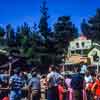
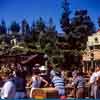


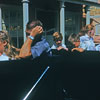





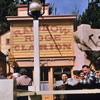























































































































































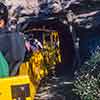


























































































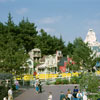























































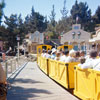


























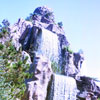
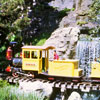















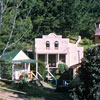








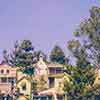







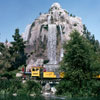





 Attractions were once thrilling not by velocity, but by the experience of seeing something not viewed anywhere else. Nature’s Wonderland was such an attraction. It was exciting just to sit in a mine car, pulled by a steam locomotive, slowly moving out of the station and into a tunnel, off to an adventure. On the way you came out of the darkness and across a large timber trestle across an expansive river with bears fishing for their dinners. Moving past there, you slowly steamed under a “natural” bridge made to look like a sandstone arch from Red Rock Canyon…just so that the real live Frontierland Pack Mules could bump and grind over and around the upcoming cactus desert. I have to say that to this day whenever I smell horse manure, I think of Frontierland. Today, the place is too cosmetic…it needs to smell; but the-powers-that-be decided it was too much odor, and that ended the pack mules that worked here. As your train gingerly banks around a grove of cactus that have taken on the expressions of human vagabonds, you see all kinds of animal life: snakes, goats, and all kinds of what would later be called Audio-Animatronics. Then rounding a curve, a large geyser starts to blow water high in the air; your train stops momentarily as the engineer tells you about how it’s unpredictable as anything else mother nature can throw at you…the stream of water stops as the engineer lays on the power…just as you round the bubbling fountain…it blows skyward just missing the people in the last car. On a hot day, everyone wanted to sit back there...but I don’t think anyone ever got wet…at least on purpose. One of the most thrilling parts of the ride was the rocks! Those damn things always scared me…even though I knew they were attached. There were spinning ones and teetering ones, and they always looked as though they were going to make me a boulder sandwich. That was the scariest part of that “thrill ride” and I miss it! Now the best part: as the heat of a Southern California hot summer day was too much to be in a diorama of the desert…you plunge into a dark, wet cavern with music from the angels singing as colored water flowed around, and under the trestle that your train is smoothly navigating, cool air is blown around...just what the doctor ordered! It’s the perfect ending as the train slowly glides into the station. What a Thrill Ride! Like I said, those were different times…
Attractions were once thrilling not by velocity, but by the experience of seeing something not viewed anywhere else. Nature’s Wonderland was such an attraction. It was exciting just to sit in a mine car, pulled by a steam locomotive, slowly moving out of the station and into a tunnel, off to an adventure. On the way you came out of the darkness and across a large timber trestle across an expansive river with bears fishing for their dinners. Moving past there, you slowly steamed under a “natural” bridge made to look like a sandstone arch from Red Rock Canyon…just so that the real live Frontierland Pack Mules could bump and grind over and around the upcoming cactus desert. I have to say that to this day whenever I smell horse manure, I think of Frontierland. Today, the place is too cosmetic…it needs to smell; but the-powers-that-be decided it was too much odor, and that ended the pack mules that worked here. As your train gingerly banks around a grove of cactus that have taken on the expressions of human vagabonds, you see all kinds of animal life: snakes, goats, and all kinds of what would later be called Audio-Animatronics. Then rounding a curve, a large geyser starts to blow water high in the air; your train stops momentarily as the engineer tells you about how it’s unpredictable as anything else mother nature can throw at you…the stream of water stops as the engineer lays on the power…just as you round the bubbling fountain…it blows skyward just missing the people in the last car. On a hot day, everyone wanted to sit back there...but I don’t think anyone ever got wet…at least on purpose. One of the most thrilling parts of the ride was the rocks! Those damn things always scared me…even though I knew they were attached. There were spinning ones and teetering ones, and they always looked as though they were going to make me a boulder sandwich. That was the scariest part of that “thrill ride” and I miss it! Now the best part: as the heat of a Southern California hot summer day was too much to be in a diorama of the desert…you plunge into a dark, wet cavern with music from the angels singing as colored water flowed around, and under the trestle that your train is smoothly navigating, cool air is blown around...just what the doctor ordered! It’s the perfect ending as the train slowly glides into the station. What a Thrill Ride! Like I said, those were different times…


























































